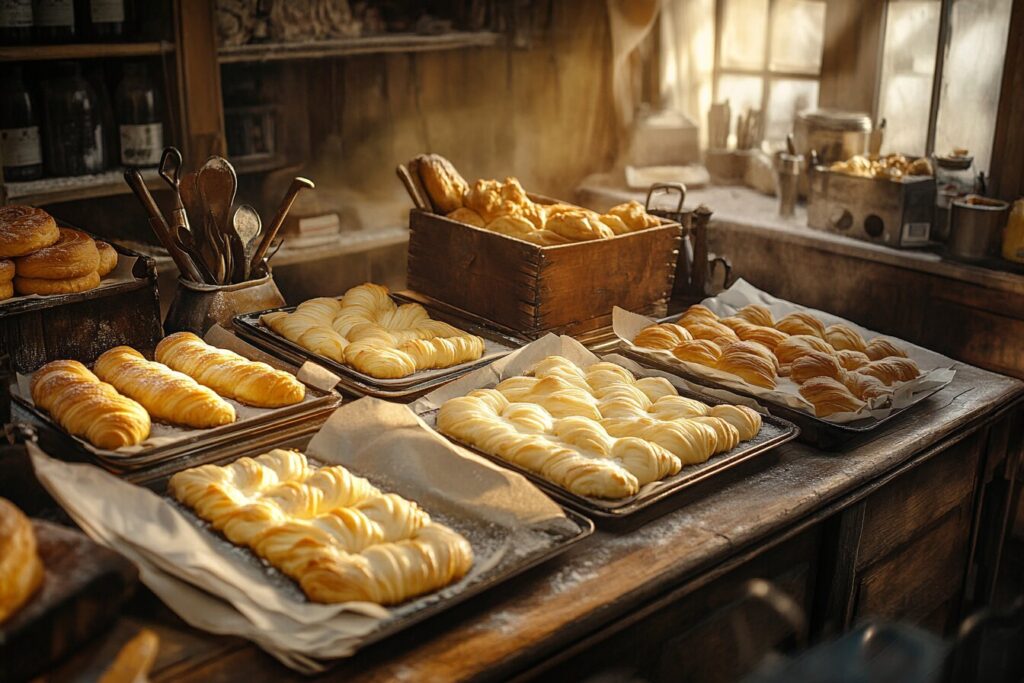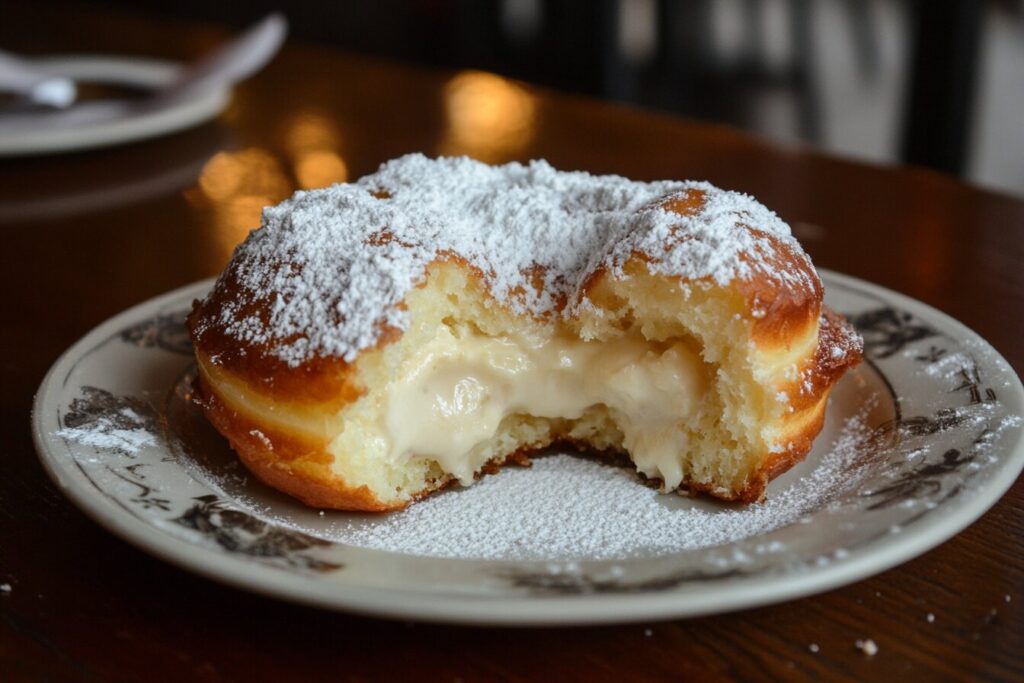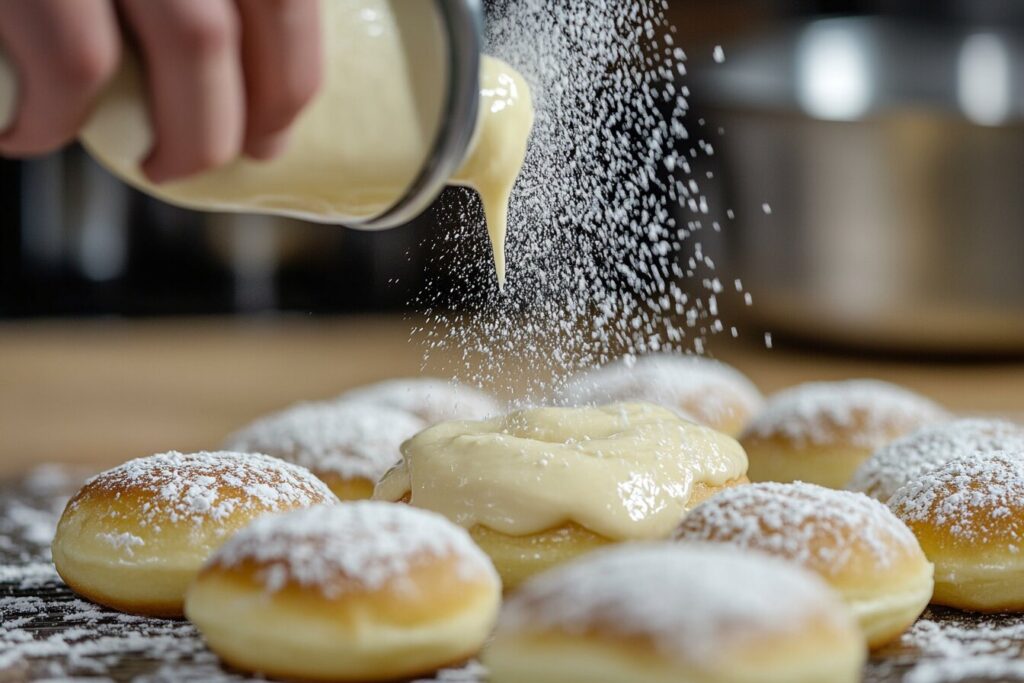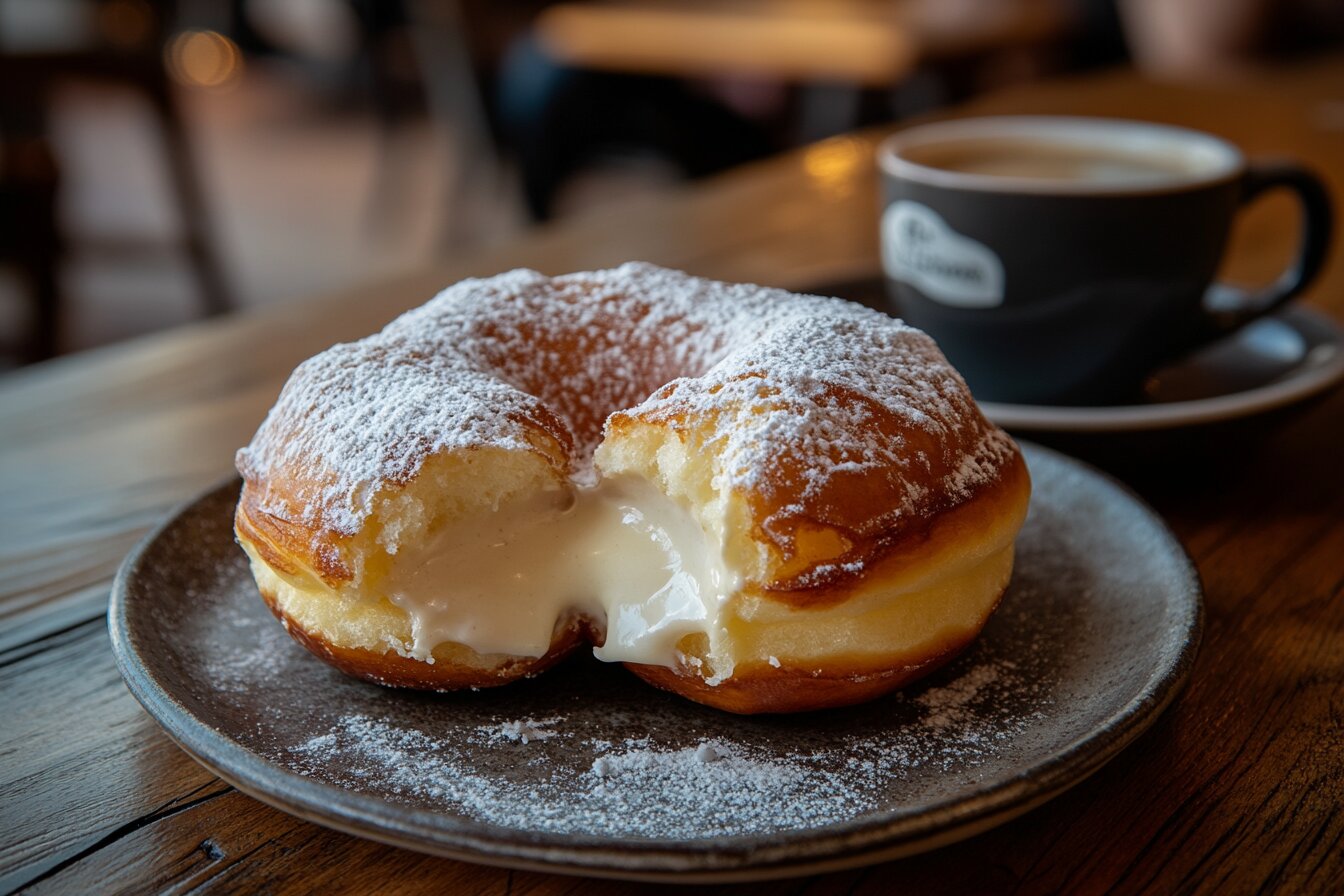The Bavarian kreme donut is a favorite in American bakeries and coffee shops. It’s known for its creamy vanilla custard filling and light dough. The dough is covered in a delicate powdered sugar coating.
This classic treat has won the hearts of many. It’s a go-to for those looking for a sweet and nostalgic experience.
Key Takeaways
- The Bavarian kreme donut features a creamy vanilla custard filling and a light, fluffy dough coated in powdered sugar.
- This classic dessert has a long history, tracing its roots back to European pastry shops and evolving into a beloved American staple.
- The unique combination of flavors and textures make the Bavarian kreme donut a truly special and indulgent treat.
- Bavarian kreme donuts can be found in bakeries and cafes nationwide, with regional variations and adaptations adding to their appeal.
- Homemade Bavarian kreme donuts are a rewarding project, allowing for customization and control over the ingredients.
History and Origins of the Bavarian Cream Tradition
The Bavarian cream’s roots go back to Europe’s rich pastry-making tradition. It first appeared in Bavaria’s pastry shops, known for their exquisite pastries. This custard-like filling was a hit from the start.
As it became more popular, Bavarian cream made its way to America. It arrived in the late 19th and early 20th centuries. This marked a big change in cream-filled pastries, leading to the famous Bavarian kreme donut.
From European Pastry Shops to American Bakeries
In the United States, Bavarian cream was welcomed with open arms. American bakers quickly took to the custard filling. They made it their own, creating beloved pastries across the country.
Evolution of Cream-Filled Pastries
- The traditional Bavarian cream inspired many variations in America.
- It led to the creation of everything from classic donuts to new pastry ideas. American bakeries showed their creativity with Bavarian cream.
- The mix of Bavarian cream with American flavors and techniques made a unique pastry tradition. It still delights people today.
The story of Bavarian cream’s journey from Europe to America shows how culinary history changes. The Bavarian kreme donut became a favorite in American bakeries. It also symbolizes the lasting bond between Bavarian cream and European pastry traditions.

What Makes a Bavarian Kreme Donut Special
The Bavarian kreme donut is a standout in the pastry world. It offers a unique mix of flavors and textures that excite the senses. At its core is a rich, creamy custard filling, making it different from other donuts.
The texture of this donut is perfect. It’s soft and pillowy on the outside, and silky smooth on the inside. Each bite is a delightful mix of light and creamy.
The Bavarian kreme donut also looks great. It’s covered in powdered sugar, adding sweetness and a snow-white finish. This makes it a treat for the eyes as well as the taste buds.
| Unique Feature | Description |
|---|---|
| Custard Filling | A rich, creamy filling that sets the Bavarian kreme donut apart from other pastries |
| Texture | A harmonious blend of soft, pillowy dough and silky smooth custard |
| Flavor Profile | An indulgent, well-balanced taste that delights the senses |
| Visual Appeal | A dusting of powdered sugar gives the donut a delicate, snow-white finish |
These special unique features, along with the custard filling, texture, and flavor profile, make the Bavarian kreme donut a favorite. It wins the hearts and taste buds of donut lovers everywhere.

The Perfect Bavarian Kreme Donut Components
The Bavarian kreme donut is a mix of three main parts: vanilla custard, fluffy dough, and powdered sugar. Each part is crucial for the perfect taste and texture. This makes the donut a favorite among many.
The Signature Vanilla Custard Filling
The heart of the Bavarian kreme donut is its creamy vanilla custard. This custard should be thick, smooth, and full of vanilla’s comforting smell. It contrasts beautifully with the soft dough, offering a rich taste experience.
Light and Fluffy Dough Characteristics
The donut dough is essential for the Bavarian kreme. It must be light, tender, and airy. A good dough ensures the donut stays soft and fluffy, even with the custard inside. It’s fried to a golden brown, making it irresistible.
Powdered Sugar Coating Techniques
The powdered sugar coating is the final step that makes the donut special. It adds a touch of sweetness and a nice contrast to the dough. The sugar should be spread evenly, enhancing the donut’s look and taste.
When the vanilla custard, airy dough, and powdered sugar come together, they create a truly delightful Bavarian kreme donut. It’s a treat for the senses.
Popular Variations and Regional Adaptations
There’s a world of flavors beyond the classic Bavarian kreme donut in the United States. From creative fillings to unique toppings, these adaptations show the donut-making community’s creativity and innovation.
The Boston cream donut is a favorite, with a rich chocolate glaze on soft dough. Another hit is the maple-bacon donut, blending sweet maple syrup with crispy bacon.
In the South, the pecan-praline donut is a treat with caramelized pecans. On the West Coast, the matcha green tea donut is loved for its subtle, earthy taste.
Donut lovers also enjoy seasonal and holiday flavors. Think pumpkin spice in fall or red velvet for Valentine’s Day. These flavors show how the classic Bavarian kreme donut can be customized in countless ways.
| Flavor Variation | Region | Description |
|---|---|---|
| Boston Cream Donut | Northeast | A classic Bavarian kreme donut with a rich chocolate glaze |
| Maple-Bacon Donut | Nationwide | A sweet and savory combination of maple syrup and crispy bacon |
| Pecan-Praline Donut | South | A Bavarian kreme donut with a caramelized pecan topping |
| Matcha Green Tea Donut | West Coast | A Bavarian kreme donut with a subtle, earthy matcha flavor |
These examples show the variety and creativity in donut recipes. They highlight the endless possibilities for flavor variations and regional specialties in the Bavarian kreme donut tradition.
Making Bavarian Kreme Donuts at Home
Making Bavarian kreme donuts at home is a fun baking adventure. With the right baking tips and ingredients, you can make these classic treats in your kitchen. Let’s explore the secrets of custard preparation and how to make them just like the bakery.
Essential Ingredients List
- All-purpose flour
- Granulated sugar
- Baking powder
- Salt
- Milk
- Butter, melted
- Eggs
- Vanilla extract
- Heavy cream
- Powdered sugar
Step-by-Step Preparation Guide
- Preheat your oven to 375°F (190°C) and grease a donut pan.
- In a large bowl, whisk together the flour, granulated sugar, baking powder, and salt.
- In a separate bowl, combine the milk, melted butter, and eggs. Mix well.
- Gradually add the wet ingredients to the dry ingredients, stirring until just combined. Be careful not to overmix.
- Spoon the batter into the prepared donut pan, filling each well about two-thirds full.
- Bake for 12-15 minutes, or until the donuts are golden brown and a toothpick inserted into the center comes out clean.
- Allow the donuts to cool in the pan for 5 minutes before transferring them to a wire rack to cool completely.
- In a medium saucepan, heat the heavy cream and vanilla extract over medium heat, stirring occasionally, until the mixture just begins to simmer.
- In a separate bowl, whisk the eggs and granulated sugar together until light and fluffy. Slowly pour the hot cream mixture into the egg mixture, whisking constantly.
- Return the mixture to the saucepan and cook over medium heat, stirring constantly, until the custard thickens enough to coat the back of a spoon.
- Allow the custard to cool completely, then transfer it to a piping bag.
- Use the piping bag to fill the center of each donut with the creamy custard.
- Dust the filled donuts with powdered sugar and serve immediately.
Common Troubleshooting Tips
- If the dough is too thick, add a tablespoon or two of milk to thin it out.
- If the custard is too thin, continue cooking it, stirring constantly, until it reaches the desired consistency.
- For a neater filling, use a small, round piping tip to inject the custard into the center of the donuts.
- If the donuts are browning too quickly, cover them with foil during the last few minutes of baking.
With these baking tips and a bit of practice, you’ll soon be making delicious homemade donuts with a creamy custard preparation. Enjoy the sweet, indulgent results of your hard work!

Nutritional Information and Dietary Considerations
Enjoying a Bavarian kreme donut means knowing its calorie count and nutritional facts. A typical serving has about 300 to 400 calories. Most of these calories come from carbs and fats.
The main nutrients in a Bavarian kreme donut are:
- Carbohydrates: 30-40 grams, mainly from the dough and sugar coating
- Fats: 15-20 grams, mostly from the cream filling and frying oil
- Protein: 4-6 grams, mostly from the egg and milk components
Bavarian kreme donuts may have traces of common allergens like dairy, wheat, and eggs. People with specific dietary restrictions or allergies should be careful.
| Nutrient | Amount per Serving |
|---|---|
| Calories | 350 |
| Total Fat | 18g |
| Saturated Fat | 9g |
| Cholesterol | 45mg |
| Sodium | 250mg |
| Total Carbohydrates | 35g |
| Dietary Fiber | 1g |
| Total Sugars | 20g |
| Protein | 5g |
For a balanced diet, Bavarian kreme donuts may not be the healthiest choice. But, they can be part of a well-rounded diet if enjoyed in moderation.
Best Serving Suggestions and Pairings
Enjoying a Bavarian kreme donut is a special treat. The right drinks and serving temperature can make it even better. These donuts go well with many drinks, and serving them just right keeps them fresh and tasty.
Complementary Beverages
A Bavarian kreme donut’s creamy filling pairs perfectly with different drinks. For instance, coffee is a classic choice, as it allows the donut’s sweetness to stand out. Alternatively, cold milk—whether dairy or non-dairy—enhances the donut’s softness and complements the creamy filling.
On the other hand, tea lovers might enjoy a black or herbal tea, such as Earl Grey or chamomile. Indeed, these teas make a nice match with the donut’s flavors.
Temperature and Freshness Tips
- Serve Bavarian kreme donuts at room temperature or slightly warm. This brings out the best flavor and texture. Don’t serve them cold, as it can ruin the donut’s balance.
- To keep them fresh, eat Bavarian kreme donuts soon after they’re made. Store them in an airtight container at room temperature for up to two days. Or, refrigerate them for up to a week.
- To make stale donuts fresh again, warm them in a 350°F oven for a few minutes. This will make them soft and flavorful once more.
Pairing Bavarian kreme donuts with the right drinks and serving them at the best temperature truly enhances the experience. Consequently, every bite will be a joy to remember.

Famous Bakeries Known for Bavarian Kreme Donuts
Some bakeries are famous for their Bavarian kreme donuts, and these popular donut shops can be found all over the country. Indeed, they offer a delicious treat that everyone loves.
For example, in Chicago, Glazed and Infused is a hit for its Bavarian kreme donuts. They use a creamy custard filling and soft dough, which makes their donuts a favorite among many.
Similarly, Voodoo Doughnut in Portland, Oregon, is known for its creative Bavarian kreme donuts. They add a vanilla twist and a sprinkle of powdered sugar. As a result, their donuts truly stand out.
| Bakery | Location | Signature Bavarian Kreme Donut |
|---|---|---|
| Glazed and Infused | Chicago, IL | Classic Bavarian Kreme |
| Voodoo Doughnut | Portland, OR | Vanilla Bavarian Kreme |
| Bouchon Bakery | Yountville, CA | Fleur de Sel Bavarian Kreme |
In Napa Valley, California, Bouchon Bakery in Yountville offers a special Bavarian kreme donut, featuring a caramel filling topped with fleur de sel. As a result, this donut has become a must-try for anyone visiting the area.
These famous bakeries have made the Bavarian kreme donut even better. They offer many flavors and textures. Whether you like the classic or something new, these renowned bakeries are the best places to try.
Storage and Shelf Life Tips
Keeping your Bavarian kreme donuts fresh is key to enjoying them. The right storage can make a big difference. It helps keep your donuts tasting great.
Here are some tips to keep your donuts fresh:
- Airtight Containers – Use a plastic or glass bin to store your donuts. This keeps moisture in and prevents drying.
- Cool, Dry Locations – Store them in a cool, dry spot, like the fridge. Avoid sunlight and heat to prevent staleness.
- Shelf Life Expectations – Stored right, donuts can last 3-5 days at room temperature or 5-7 days in the fridge. Freezing can also extend their life.
By following these donut storage and freshness preservation tips, you can enjoy your Bavarian kreme donuts for longer. They’ll stay delicious for whenever you want one.
Alternative Dietary Options and Modifications
The Bavarian kreme donut is a favorite treat for many. But, it might not fit everyone’s dietary needs. Luckily, there are many alternatives that make this sweet treat accessible to all.
Gluten-Free Variations
Those who can’t eat gluten face a challenge with traditional Bavarian kreme donuts. But, clever bakers have come up with gluten-free versions. They use gluten-free flours like almond flour to make these donuts just as tasty and satisfying.
Vegan Adaptations
As more people adopt plant-based diets, there has been a noticeable rise in vegan desserts. Fortunately, the Bavarian kreme donut can easily be made vegan by swapping out dairy for plant-based milk and using vegan custard. In this way, everyone can enjoy this classic dessert, regardless of dietary preferences.
| Dietary Consideration | Ingredient Substitutions | Preparation Modifications |
|---|---|---|
| Gluten-Free |
|
|
| Vegan |
|
|
With these alternatives, everyone can enjoy the Bavarian kreme donut. It’s all about finding the right version that fits your dietary needs and preferences.
Conclusion
The Bavarian kreme donut is a beloved classic in pastry and dessert culture. It is adored for its light dough and rich, creamy vanilla custard filling. Indeed, these qualities have captured the hearts—and taste buds—of many over the years.
Even as dessert trends evolve, the Bavarian kreme donut remains a timeless favorite. This enduring popularity highlights the lasting charm of such a traditional treat. Whether enjoyed as a breakfast or an afternoon snack, it consistently brings joy to many across the U.S.
Are you exploring donuts? If so, try a Bavarian kreme donut and savor its rich history and artistry. Whether made by professional bakers or in your own kitchen, it reflects the true beauty of pastry culture. Above all, it remains a delightful indulgence for dessert lovers everywhere.
FAQ
What is a Bavarian Kreme Donut?
A Bavarian Kreme Donut is a classic pastry. It has a fluffy dough and a rich vanilla custard inside. It’s covered in powdered sugar, making it both beautiful and tasty.
What are the key ingredients in a Bavarian Kreme Donut?
The main parts of a Bavarian Kreme Donut are a light dough, creamy vanilla custard, and powdered sugar. Together, they make this dessert special.
How did the Bavarian Cream tradition originate?
The Bavarian Cream tradition started in European pastry shops. These cream-filled treats were loved by many. They became popular in American bakeries, evolving into the Bavarian Kreme Donut we know today.
What sets Bavarian Kreme Donuts apart from other pastries?
Bavarian Kreme Donuts stand out because of their unique taste and texture. The creamy filling, soft dough, and powdered sugar on top make them a treat to enjoy.
How can I make Bavarian Kreme Donuts at home?
To make Bavarian Kreme Donuts at home, you’ll need yeast, flour, sugar, eggs, and cream. Follow a guide to make the dough and custard. Pay attention to frying or baking and use tips to avoid common mistakes.
Are there any dietary variations or alternative options for Bavarian Kreme Donuts?
Yes, there are options for those with dietary needs. You can make gluten-free or vegan Bavarian Kreme Donuts. Use the right substitutes and ingredients to enjoy this pastry without worrying about dietary restrictions.

